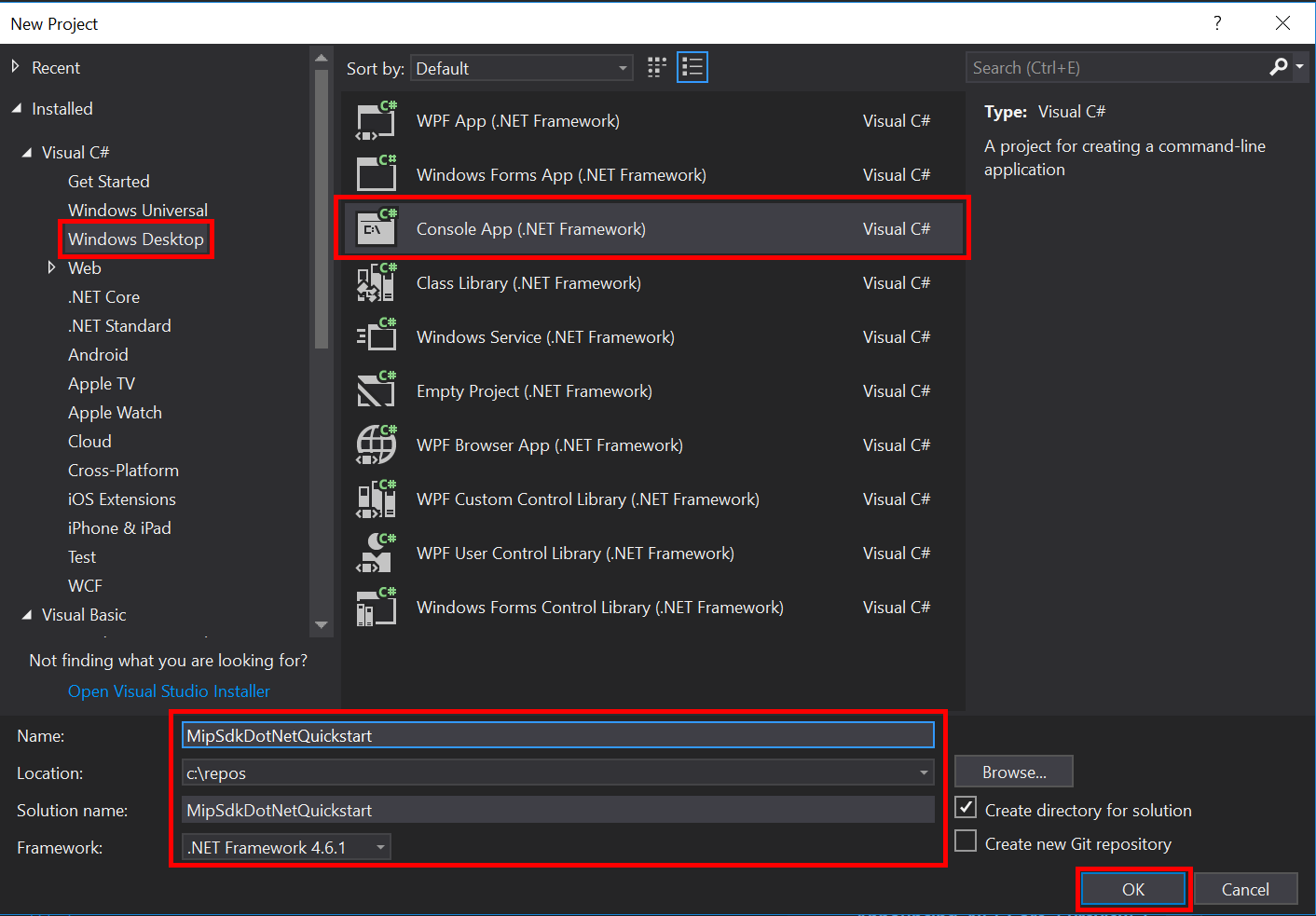Note
Access to this page requires authorization. You can try signing in or changing directories.
Access to this page requires authorization. You can try changing directories.
This quickstart will show you how to implement the client initialization pattern, used by the MIP SDK .NET wrapper at runtime.
Note
The steps outlined in this quickstart are required for any client application that uses the MIP .NET wrapper's Protection SDK. These Quickstarts should be done serially after Application Initialization and implementation of Authentication delegate and Consent delegate classes.
Prerequisites
If you haven't already, be sure to:
- Complete the steps in Microsoft Information Protection (MIP) SDK setup and configuration. This "Protection Profile and Engine set up" Quickstart relies on proper SDK setup and configuration.
- Optionally:
- Review Profile and engine objects. The profile and engine objects are universal concepts, required by clients that use the MIP File/Policy/Protection SDKs.
- Review Authentication concepts to learn how authentication and consent are implemented by the SDK and client application.
Create a Visual Studio solution and project
First we create and configure the initial Visual Studio solution and project, upon which the other Quickstarts will build.
Open Visual Studio 2019 or later, select the File menu, New, Project. In the New Project dialog:
Add the NuGet package for the MIP File SDK to your project:
- In the Solution Explorer, right click on the project node (directly under the top/solution node), and select Manage NuGet packages...:
- When the NuGet Package Manager tab opens in the Editor Group tabs area:
- Select Browse.
- Enter "Microsoft.InformationProtection" in the search box.
- Select the "Microsoft.InformationProtection.File" package.
- Click "Install", then click "OK" when the Preview changes confirmation dialog displays.
Repeat the steps above for adding the MIP Protection SDK package, but instead add "Microsoft.IdentityModel.Clients.ActiveDirectory" to the application.
Implement an authentication delegate and a consent delegate
If not already implemented, follow the steps listed in File SDK application initialization for implementing authentication and consent delegate.
Initialize the MIP SDK Managed Wrapper
From Solution Explorer, open the .cs file in your project that contains the implementation of the
Main()method. It defaults to the same name as the project containing it, which you specified during project creation.Remove the generated implementation of
main().The managed wrapper includes a static class,
Microsoft.InformationProtection.MIPused for initialization, creating aMipContext, loading profiles, and releasing resources. To initialize the wrapper for File SDK operations, callMIP.Initialize(), passing inMipComponent.Protectionto load the libraries necessary for protection operations.In
Main()in Program.cs add the following, replacing <application-id> with the ID of the Microsoft Entra Application Registration created previously.
using System;
using System.Threading.Tasks;
using Microsoft.InformationProtection;
using Microsoft.InformationProtection.Exceptions;
using Microsoft.InformationProtection.Protection;
namespace mip_sdk_dotnet_quickstart
{
class Program
{
private const string clientId = "<application-id>";
private const string appName = "<friendly-name>";
static void Main(string[] args)
{
//Initialize Wrapper for Protection SDK operations
MIP.Initialize(MipComponent.Protection);
}
}
}
Construct a Protection Profile and Engine
As mentioned, profile and engine objects are required for SDK clients using MIP APIs. Complete the coding portion of this Quickstart, by adding code to load the native DLLs and then instantiate the profile and engine objects.
using System;
using System.Threading.Tasks;
using Microsoft.InformationProtection;
using Microsoft.InformationProtection.Exceptions;
using Microsoft.InformationProtection.Protection;
namespace mip_sdk_dotnet_quickstart
{
class Program
{
private const string clientId = "<application-id>";
private const string appName = "<friendly-name>";
static void Main(string[] args)
{
// Initialize Wrapper for Protection SDK operations.
MIP.Initialize(MipComponent.Protection);
// Create ApplicationInfo, setting the clientID from Azure AD App Registration as the ApplicationId.
ApplicationInfo appInfo = new ApplicationInfo()
{
ApplicationId = clientId,
ApplicationName = appName,
ApplicationVersion = "1.0.0"
};
// Instantiate the AuthDelegateImpl object, passing in AppInfo.
AuthDelegateImplementation authDelegate = new AuthDelegateImplementation(appInfo);
// Create MipConfiguration Object
MipConfiguration mipConfiguration = new MipConfiguration(appInfo, "mip_data", LogLevel.Trace, false);
// Create MipContext using Configuration
mipContext = MIP.CreateMipContext(mipConfiguration);
// Initialize and instantiate the ProtectionProfile.
// Create the ProtectionProfileSettings object.
// Initialize protection profile settings to create/use local state.
var profileSettings = new ProtectionProfileSettings(mipContext,
CacheStorageType.OnDiskEncrypted,
new ConsentDelegateImplementation());
// Load the Profile async and wait for the result.
var protectionProfile = Task.Run(async () => await MIP.LoadProtectionProfileAsync(profileSettings)).Result;
// Create a ProtectionEngineSettings object, then use that to add an engine to the profile.
var engineSettings = new ProtectionEngineSettings("user1@tenant.com", authDelegate, "", "en-US");
engineSettings.Identity = new Identity("user1@tenant.com");
var protectionEngine = Task.Run(async () => await protectionProfile.AddEngineAsync(engineSettings)).Result;
// Application Shutdown
// handler = null; // This will be used in later quick starts.
protectionEngine = null;
protectionProfile = null;
mipContext = null;
}
}
}
Replace the placeholder values in the source code that you pasted in, using the following values:
Placeholder Value Example <application-id> The Microsoft Entra Application ID assigned to the application registered in "MIP SDK setup and configuration" (2 instances). 0edbblll-8773-44de-b87c-b8c6276d41eb <friendly-name> A user-defined friendly name for your application. AppInitialization Now do a final build of the application and resolve any errors. Your code should build successfully.
Next Steps
Now that your initialization code is complete, you're ready for the next quickstart, where you'll start to experience the MIP Protection SDKs.
